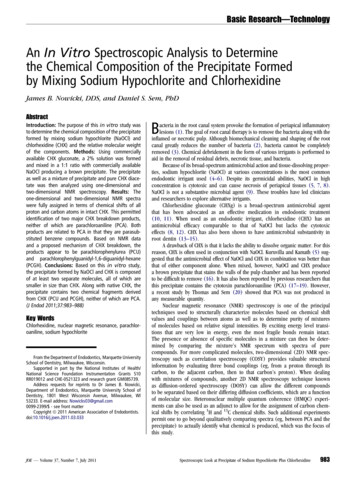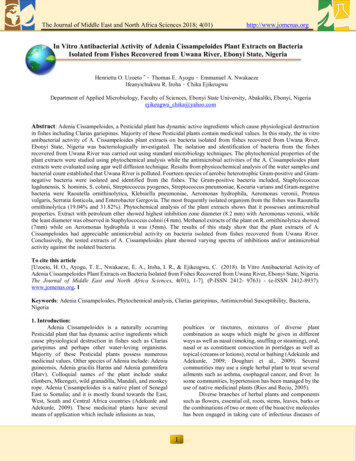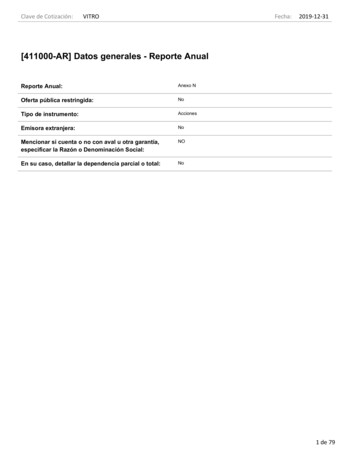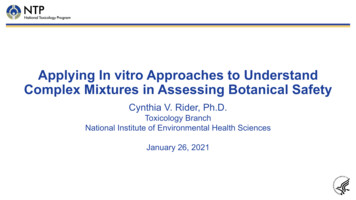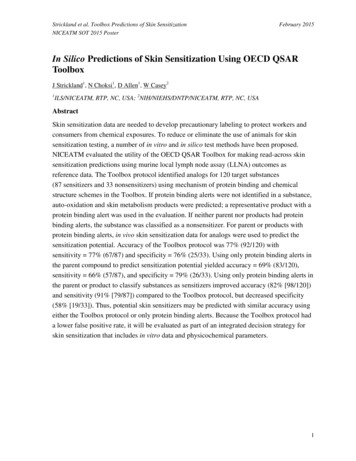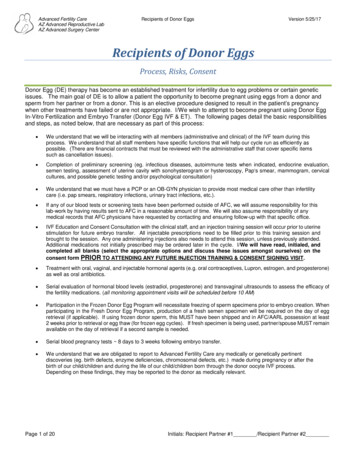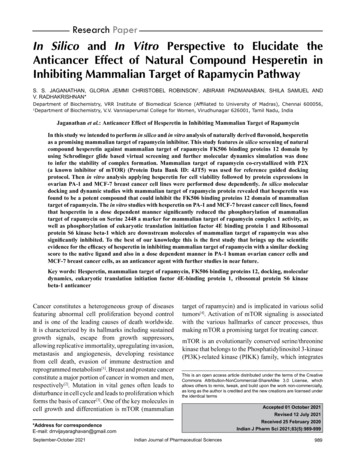
Transcription
Research PaperIn Silico and In Vitro Perspective to Elucidate theAnticancer Effect of Natural Compound Hesperetin inInhibiting Mammalian Target of Rapamycin PathwayS. S. JAGANATHAN, GLORIA JEMMI CHRISTOBEL ROBINSON1, ABIRAMI PADMANABAN, SHILA SAMUEL ANDV. RADHAKRISHNAN*Department of Biochemistry, VRR Institute of Biomedical Science (Affiliated to University of Madras), Chennai 600056,1Department of Biochemistry, V.V. Vanniaperumal College for Women, Virudhunagar 626001, Tamil Nadu, IndiaJaganathan et al.: Anticancer Effect of Hesperetin in Inhibiting Mammalian Target of RapamycinIn this study we intended to perform in silico and in vitro analysis of naturally derived flavonoid, hesperetinas a promising mammalian target of rapamycin inhibitor. This study features in silico screening of naturalcompound hesperetin against mammalian target of rapamycin FK506 binding proteins 12 domain byusing Schrodinger glide based virtual screening and further molecular dynamics simulation was doneto infer the stability of complex formation. Mammalian target of rapamycin co-crystallized with P2X(a known inhibitor of mTOR) (Protein Data Bank ID: 4JT5) was used for reference guided dockingprotocol. Then in vitro analysis applying hesperetin for cell viability followed by protein expressions inovarian PA-1 and MCF-7 breast cancer cell lines were performed dose dependently. In silico moleculardocking and dynamic studies with mammalian target of rapamycin protein revealed that hesperetin wasfound to be a potent compound that could inhibit the FK506 binding proteins 12 domain of mammaliantarget of rapamycin. The in vitro studies with hesperetin on PA-1 and MCF-7 breast cancer cell lines, foundthat hesperetin in a dose dependent manner significantly reduced the phosphorylation of mammaliantarget of rapamycin on Serine 2448 a marker for mammalian target of rapamycin complex 1 activity, aswell as phosphorylation of eukaryotic translation initiation factor 4E binding protein 1 and Ribosomalprotein S6 kinase beta-1 which are downstream molecules of mammalian target of rapamycin was alsosignificantly inhibited. To the best of our knowledge this is the first study that brings up the scientificevidence for the efficacy of hesperetin in inhibiting mammalian target of rapamycin with a similar dockingscore to the native ligand and also in a dose dependent manner in PA-1 human ovarian cancer cells andMCF-7 breast cancer cells, as an anticancer agent with further studies in near future.Key words: Hesperetin, mammalian target of rapamycin, FK506 binding proteins 12, docking, moleculardynamics, eukaryotic translation initiation factor 4E-binding protein 1, ribosomal protein S6 kinasebeta-1 anticancerCancer constitutes a heterogeneous group of diseasesfeaturing abnormal cell proliferation beyond controland is one of the leading causes of death worldwide.It is characterized by its hallmarks including sustainedgrowth signals, escape from growth suppressors,allowing replicative immortality, upregulating invasion,metastasis and angiogenesis, developing resistancefrom cell death, evasion of immune destruction andreprogrammed metabolism[1]. Breast and prostate cancerconstitute a major portion of cancer in women and men,respectively[2]. Mutation in vital genes often leads todisturbance in cell cycle and leads to proliferation whichforms the basis of cancer[3]. One of the key molecules incell growth and differentiation is mTOR (mammaliantarget of rapamycin) and is implicated in various solidtumors[4]. Activation of mTOR signaling is associatedwith the various hallmarks of cancer processes, thusmaking mTOR a promising target for treating cancer.mTOR is an evolutionarily conserved serine/threoninekinase that belongs to the Phosphatidylinositol 3-kinase(PI3K)-related kinase (PIKK) family, which integratesThis is an open access article distributed under the terms of the CreativeCommons Attribution-NonCommercial-ShareAlike 3.0 License, whichallows others to remix, tweak, and build upon the work non-commercially,as long as the author is credited and the new creations are licensed underthe identical termsRevised 12 July 2021Received 25 February 2020*Address for correspondenceE-mail: drrvijayaraghavan@gmail.comSeptember-October 2021Accepted 01 October 2021Indian J Pharm Sci 2021;83(5):989-999Indian Journal of Pharmaceutical Sciences989
www.ijpsonline.coma variety of exogenous signals to coordinate numerouscellular processes, that includes cell growth andmetabolism[4-6]. It is known to form two complexes,mTOR complex 1 (mTORC1) and 2 (mTORC2),which regulates protein synthesis and cytoskeletalfunction, respectively[7,8]. mTORC1 regulates nutrientand energy supply, related to several growth factorsignals, essential for cell growth and also regulatesautophagy[9,10]. mTORC2 functions primarily andmediates cytoskeletal organization moreover italso plays a significant role in cancer progressionby facilitating cancer cell migration, invasion andmetastasis[11,12]. When mTOR is deregulated andhomeostasis is compromised, it implicates metabolicdiseases like diabetes and cancer[13]. Therefore, mTORinhibition has been considered as promising therapeuticstrategy for cancer and metabolic diseases.Currently, plant derived bioactive compounds areconsidered as an alternative and effective anticancertherapeutics for cancer treatment, as they are easilyavailable and natural. Moreover they can be easilyadministered even orally and can also be a part of ourdietary intake without causing any side effects[14,15].In addition, as they are naturally derived compoundsthey are highly tolerant, with higher bioavailability andleast toxicity. If these naturally derived compoundsshow effective cytotoxicity to cancer cells, thesecompounds can be considered as lead compounds forfurther therapeutic development. Among the variousphenolic compounds, flavonoids such as hesperetincommonly found in citrus fruits are used in traditionalChinese medicine[16]. Hesperetin (3’,5,7-trihydroxy-4methoxyflavonone), is known for its pharmacologicalfunctions such as anti-inflammatory, antihypertensive,antiatherogenic effects with higher antioxidantproperties[17-19]. In addition, recent studies have reportedthat hesperetin might be a potent anticancer agent invarious cancer types such as, colon, breast, prostate andcervical cancers[20-23]. Although the effect of hesperetinon some of the signaling pathways like MitogenActivated Protein Kinase (MAPK), Notch1 had beenexplored[24,25], the molecular mechanism on inhibitingPI3K/AKT/mTOR pathway have not been determinedso far.A previous in silico and in vitro study have reported theinteraction of hesperetin on DNA binding domain ofNuclear factor kappa-light-chain-enhancer of activatedB cells (NFκB) and thereby regulating apoptosis[24]. Inorder to determine whether hesperetin have same effect990on mTOR signaling cascade, both in silico and in vitroapproaches are implemented in this study (fig. 1).MATERIALS AND METHODSProtein preparation:The co-crystal structure of mTOR with co-crystallizedligand P2X midin-3-yl]-1H-indol-5-ol) (PDB ID:4JT5)[26]was used as the structural template for moleculardocking approach. In specific, the kinase domain(Val1869-Thr2346) of chain B was considered furtherand by using Protein Preparation Wizard of Schrödinger(New York, NY, USA) the domain was pre-processedand optimized. The structure was optimized by assigningproper bond order, removing steric clashes and byassigning the optimal protonation states for histidineresidues and adjusting the chi rotation of asparagine,glutamine and histidine residues accordingly. Finally,the geometrically optimal structure obtained fromenergy minimization with OPLS 2005 (Schrödinger)was used for grid generation. Further, the activebinding site residues; Leu2185, Lys2187, Asp2195,Tyr2225, Ile2237, Tyr2239, Val 2240, Met2345,Ile2356, Asp2357, Phe2358 was used for docking gridgeneration. In addition, 1.0 Ǻ for Van der Waals radiiscaling factor and 0.25 Ǻ of partial cutoff was set to thereceptor grid and proceeded for the virtual screeningprocess.Ligand preparation:The structure of ligands hesperetin (Accession Number:DB01094) optimal 3-dimensional (3D) structureswere generated using Ligprep Module, by fixing itsionization states, tautomer’s and other stereo chemicalerrors. Further, the optimal chiral forms of thesestructures were energy minimized using the OPLS2005 force field and were used for docking against thekinase domain of mTOR.Fig. 1: Chemical structure of hesperetinIndian Journal of Pharmaceutical SciencesSeptember-October 2021
www.ijpsonline.comRe-docking of P2X:The P2X structure was retrieved from the co-crystallizedcrystal structure (PDB ID:4JT5) and were preparedand re-docked to the active cavity using Glide XP(Schrödinger, LLC, New York, NY), where the ligandsampling was set rigid. The binding affinity of P2X wascalculated using Glide score and finally, the bindingfree energy of the complex was calculated using PrimeMolecular Mechanics/Generalized Born Surface Area(MM/GBSA)[27]. Moreover, the interaction profile ofthe re-docked ligand with the mTOR kinase domainwas analysed using Ligplot.Docking:The docking of the prepared ligands (Hesperetin)to the active cavity was carried out using Glide SP(standard precision). The binding affinity of the dockedligands was calculated using Glide score. Followingwhich the binding free energy of the docked ligandswere calculated using Prime MMGBSA (molecularMechanics/Generalized Born Surface Area) (10.1016/j.lfs.2018.10.022). Further the interaction profile of theligands with the mTOR kinase domain was analysedusing Ligplot.ADME studies:The compounds clearing the absorption, distribution,metabolism and excretion filter (ADME) properties areknown to surpass the clinical trials and emerge as bestcompound. Hence, in this study FAF Drug3.0 server[28]was used to predict the physicochemical properties thatare essential for conferring the ADME properties like:Molecular weight (MW), predicted qualitative oralabsorption and Lipinski’s rule of five[29].Toxicity prediction:Similarly, toxicity analysis is important criteria todetermine the drug’s efficacy, the compounds toxicityprediction was carried out using FAF-Drug 3.0 server[29]for calculating properties such as drug likeness,Topological Polar Surface Area (TPSA), ClogP andsolubility, mutagenic and tumorigenic effects.Molecular Dynamics (MD) simulation:MD simulation has become an indispensable tool incomputational biology research towards understandingthe dynamic behavior of molecular complexes andintermolecular interactions in physiologically simulatedconditions[30-33]. Hence, in this study, we implementedexplicit MD simulations using the Desmond packageSeptember-October 2021(Desmond MD System, version 3.1, D. E. ShawResearch, New York, NY, 2012; Maestro-DesmondInteroperability Tools, version 3.1, Schrödinger, NewYork, NY, 2012) with OPLS2005 as force field. Thecomplete system for MD was build using predefinedwater model Simple Point Charge (SPC) as solvent ina cubic box (10 Å 10 Å 10 Å) dimension as periodicboundary. Further, to neutralize the system, Na counterions were added. Implementing Steepest Descent andthe limited-memory Broyden-Fletcher-GoldfarbShanno (LBFGS) algorithms, the complete systemwas energy minimized in a hybrid manner. Followingwhich, the Isothermal-isobaric (NPT) ensemble wasinitiated and the production run was performed.The temperature was set to 300K and maintainedthroughout by implementing Nose–Hoover thermostatwith the pressure set to 1.0 bar and maintained throughMartyna–Tobias Klein pressure bath. Smooth ParticleMesh Ewald method implementing SHAKE algorithmwas applied to analyze the electrostatic interactions witha cutoff value of 9.0 Å distance. Finally, the productionrun was carried out for 20 ns and the final trajectorysampling for analysis was recorded at an interval of1.0 ps[34-36].Maintenance of cell lines:Ovarian cancer (PA-1) cells and MCF-7 breast cancercells were obtained from National Centre for CellScience (NCCS) (Pune, India) was maintained and grownin a humidified incubator at 37 with 5 % carbondioxide(CO2). Cells were grown as a monolayer in plastictissue culture (T25) flasks in Dulbecco's ModifiedEagle's Medium (DMEM) (Gibco, Grand Island, NewYork, USA). The medium was supplemented with10 % Fetal Bovine Serum (FBS) (Gibco, Grand Island,New York, USA) and antibiotics (penicillin 50 IU/ml,streptomycin 3.5 μg/ml and gentamycin 2.5 μg/ml)(Gibco, Grand Island, New York, USA).Treatment of cells:Cells were seeded (at 2.5 105/ml per 5 ml) in T25 flaskand incubated for 3 d (to confluence) before treatment.On the day of treatment, cells were washed using5 ml of sterile Phosphate Buffered Saline (PBS) and anappropriate culture medium containing the drug(s) ofinterest was added to the wells.Cell viability assay:Cell viability was determined by olium bromide (MTT)assay. PA-1 and MCF-7 breast cancer cells (5 103Indian Journal of Pharmaceutical Sciences991
www.ijpsonline.comcells/well) were seeded in 96-well culture plates.After overnight incubation, various concentrations ofhesperetin were added to the cells for varying timesfollowed by the addition of 20 µl MTT at 37 for 4 h.Optical Density (OD) was measured at 550 nm using anmicroplate reader (Bio Rad, CA, USA). Cell viabilitywas expressed as a percentage of untreated cells.Protein preparation and western blot analysis:After 48 h of treatment the PA-1 cells and MCF-7 breastcancer cells were lysed with Radio-ImmunoprecipitationAssay (RIPA) buffer, containing the protease inhibitorcocktail and sodium orthovanadate (Santa Cruz Inc.,Dallas, TX, USA), for 30 min at 4 . Cell lysates wereclarified by centrifugation at 4 for 10 min at 12 000rpm and then protein concentrations were determinedby using Bicinchoninic acid (BCA) protein assaymethod (Thermo Fisher Scientific, Grand Island, NY,USA). For the western blot analysis equal concentrationof proteins were separated using Sodium DodecylSulfate Polyacrylamide Gel Electrophoresis (SDSPAGE) and blotted onto a nitrocellulose membrane(GE Healthcare, Pittsburgh, PA, USA). After proteintransfer the membranes were blocked using 4 %bovine serum albumin (BSA) and probed with specificantibodies for Phospho mTOR and p-p70S6K andβ-actin was used as internal control (Santa Cruz Inc.,Dallas, TX, USA). Finally, for the detection of specificproteins, the membranes were incubated in a solutioncontaining chemiluminescent substrate. Densitometryanalyses were performed using the ImageJ program.Statistics analysis:Data were represented as mean standard error of themean (SEM). Statistical significance was analysed usingAnalysis of Variance (ANOVA) and Dunnett’s multiplecomparison test between the groups, using GraphPadPrism7.0 software package. p 0.05 was consideredto be statistically significant all the experiments weredone in triplicates.RESULTS AND DISCUSSIONThe crystal structure for mTOR was retrieved fromPDB (PDB ID:4JT5, Resolution: 3.5 Å, R value: 0.271)(fig. 2a) and optimized using Schrödinger maestro. Thestructure of mTOR B chain consists of the N-terminalkinase domain and the kinase domain (1869–2346)(fig. 2b). The structure was found to be co-crystallizedwith P2X showing hydrogen bond interactions withAsp2195 and Val2240 (fig. 2c). The hinge regionresidues (2185–2360) of kinase domain consists ofactive site residues; Asp2195 and Val2240 which arenoted to be critical for hydrogen-bond formation withinhibitors.Fig. 2: (a) Represents the cartoon representation of mTOR chain B (PDB ID:4JT5); where the N-terminal domain is shown in bluecolor and kinase domain is shown in orange color with P2X ligand shown as stick representation (magenta color); (b) Representsthe kinase domain (1869–2346) of mTOR along with P2X ligand; (c) Ligplot representing the interaction of P2X with mTOR in theco-crystallized structure; PDB ID 4JT5; (d) Redocked P2X; (e) Hesperetin represents the 2D interaction diagram of ligands dockedto the kinase domain (active site) of mTOR992Indian Journal of Pharmaceutical SciencesSeptember-October 2021
www.ijpsonline.comThe re-docking of P2X to mTOR was performedusing Glide XP mode. The docking results inferredsynonymous interactions as observed in the cocrystal form. Similarly, hydrogen bonding of P2X toAsp2195, Val2240 and Gly2238 and a π-π interactionwith Trp2239 in the active site of mTOR’s chain B wasobserved (fig. 2d). Further, Prime/MMGBSA scorewas observed to be -60 kcal/mol with docking score of-11.09 kcal/mol for re-docked pose (Table 1).chemical properties within the range of recommendedrange of computed descriptors representing ADMEproperties (Table 2). Similarly, the oral bio-availabilitywas estimated using VEBER’S rule, wherein, theselected compound showed very good bioavailability(Table 3). Solubility index for the compounds werealso calculated, which inferred P2X to have reducedsolubility were as hesperetin have good solubility(Table 3).From Table 1, it can inferred the hesperetin compoundhas showed binding affinity of -10.85 kcal/molapproximately equal when compared to P2X(-11.09 kcal/mol). On comparing the Prime/MMGBSAscore (Table 1), it was observed that hesperetin hasbinding free energy of -43.3 kcal/mol, which wassignificantly comparable to P2X (-60 kcal/mol).Moreover, based on the protein-ligand interactionprofile analysis (fig. 2d), it was inferred that hesperetincompounds showed a strong hydrogen bond withAsp2195 and two hydrogen bonds with Val2240 whichspans the hydrophilic cavity and being more specificto P2X and shall serve as specific inhibitor (fig. 2e). Inaddition hesperetin also showed a π-π interaction withthe active cavity residue Trp2239.Further, the GSK 4/400 Rule (FAF-Drug3) Pfizer3/75 Rule and Golden triangle rule were alsoimplemented to evaluate the drug safety profiling,wherein, all these compounds were found to be fit withhigh confidence (fig. 3 and fig. 4).Further, the compound hesperetin was subjected toin silico ADME predictions such compounds showingphysico-chemical properties within the allowed rangesuch as molecular weight (130-725 Da), Estimatednumber of hydrogen bonds (2.0-20.0), Estimatednumber of hydrogen bonds donors (0.0-6.0) Lipinski’srule of five (max violation 4) are considered as potentialleads. All compounds showed significant physicoTABLE 1: POST DOCKING ANALYSIS OF THECOMPOUNDS BASED ON GLIDE SCORE ANDBINDING FREE ENERGY1P2XGlide score(kcal/mol)-11.0192Hesperetin-10.85S. NoLigandPrime/MM-GBSA(kcal/mol)-60-43.3From the trajectory analysis of the apoenzyme (apo)form, it was noted that the backbone Root MeanSquare Deviation (RMSD) of mTOR (fig. 5a) proteinhas maintained deviations ranging 4.0-5.98 Ǻ witha standard deviation of 0.783 Å for 20 ns simulationwithout any convergence and has shown varyingconformational changes. It is inferred from the radiusof gyration plot (Rg) (fig. 5b) that the protein has notattained any compactness during 20 ns of simulationshowing the open conformation of the protein since ithas increased Rg value. The RMSF plot (fig. 5c) showsthat His2277, Lys1867, Asp2276, Pro2273, Asp2274,Thr2279, Lys1868, Leu2278, Thr2436 of the kinasedomain has attained the maximum fluctuations around 7.5-6.5 Ǻ.The RMSD plot of mTOR-P2X complex (fig. 6a)showed a maximum deviation of 4.83 Ǻ initially, yet ithas tried to converge and has maintained it throughoutthe simulation run with minimum deviation of 0.525Å for 20 ns. Moreover, the radius of gyration plot(fig. 6b) also showed that the complex has maintainedits compactness within the range of 28 Å with aminimum of 0.25 Å deviation From the RMSF plot(fig. 6c) it was noted that the residue Thr2436 hasfluctuations of about 7.2 Å, apart from the C-terminalTABLE 2: PREDICTED PHYSICO-CHEMICAL DESCRIPTORS FOR ADMES. NoLigandMWlogPlogDlogSwHB DonorHB AcceptorRule of 2.56-3.47360TABLE 3: SHOWING ORAL BIOAVAILABILITY AND SOLUBILITY PREDICTIONS FOR THE COMPOUNDSLigandP2XOral bioavailability of compounds based on VEBER’S ruleNo of rotatableOral nSeptember-October 2021296.22GoodIndian Journal of Pharmaceutical SciencesFAF-Drug3 PredictionSolubilitySolubility forecast(mg/l)index12227.2Reduced Solubility9436.21Good Solubility993
www.ijpsonline.comFig. 3: Toxicity analysis using Pfizer 3/75 rule. The compounds with ( 3 log P value) and TPSA ( 75) is termed as toxic compoundand they fall in red square of the plot, (a) Redocked P2X; (b) HesperetinFig. 4: Toxicity analysis using golden triangle rule. The compounds which falls inside the yellow triangle are likely to have anoptimal permeability and a good metabolic stability, (a) Redocked P2X; (b) HesperetinFig. 5: Molecular dynamics simulation of mTOR, (a) Represents the RMSD plots of apo form of mTOR showing deviation 0.783Å;(b) Radius of gyration plots of apo form of mTOR representing the compactness of the protein; (c) RMSF plots of apo form ofmTOR representing the fluctuations of the residues994Indian Journal of Pharmaceutical SciencesSeptember-October 2021
www.ijpsonline.comresidues conferring the loop region. The number ofinter hydrogen bonds of the mTOR-P2X complex (fig.6d) showed 6 hydrogen bonds initially where only 3-4hydrogen bonds were maintained throughout the 20 nssimulation. From the interaction analysis (fig. 6e andfig. 6f), it is noted that the Asp2195, Gly2238, Val2240has constantly maintained its interactions with P2X,apart from that Trp2239 has maintained its hydrophobiccontact with P2X.The RMSD plot of this complex (fig. 7a) has maintaineda range of 2.95 Å -3.5 Å with minimum deviationsof 0.425 Å. The protein has tried to converge from3-10 ns initially, yet they showed gradual increaseat 14 ns and have tried to remain stable till 20 ns.The complex has tried to maintain its compactnessof 27.857 Å as shown in the radius of gyration plot,with the minimum Rg value (fig. 7b). The RMSF plot(fig. 7c) revealed that only Asp2276 residue has showedmaximum fluctuations of 6.2 Å, whereas overallall the residues have showed minimum fluctuationswhen compared to the apo form of mTOR. ThemTOR-hesperetin complex stability is maintained by5 hydrogen bonds among which only 2-3 inter hydrogenbonds were maintained throughout the simulationas shown in (fig. 7d). From the interaction analysis(fig. 7e and fig. 7f), it is noted that residues Val2240,cys2243 has constantly maintained its interaction withhesperetin, whereas interactions formed by residuesTrp2239 and Asp2195 are partial initially and hasmaintained it after 10 ns till the end of MD productionrun. From the trajectory analysis on both apo and holoforms of mTOR, it is revealed that the mTOR-hesperetincomplex has showed a minimum deviation amongthe apo and other holo forms. Moreover, the mTORhesperetin complex also had lowest Rg value therebyhighlighting the compactness of the protein complex.In order to understand the stability of predicted proteinligand complexes, the inter hydrogen bond formationduring the course of 20 ns simulation was analyzedand it was inferred that the mTOR-hesperetin complexalso has maintained its stable interactions throughoutthe simulation. Overall, the Asp2195, Val2240, theimportant residues involved in interaction with thewell-known inhibitor P2X is also well maintainedthroughout the md production run. Based on all theanalysis performed, we strongly propose that mTOR–hesperetin to be more stable complex.Fig. 6: Molecular dynamics simulation of mTOR-P2X. mTOR-P2X Redocked complex, (a) Represents the RMSD plots withdeviation of 0.525 Å; (b) Radius of gyration plots of representing the compactness of the protein mTOR-P2X; (c) RMSF plots ofmTOR-P2X representing the fluctuations of the residues; (d) Plots representing the number of inter hydrogen bonds complexesshowing the stability of the mTOR-P2X; (e) Representing the residues involved in hydrogen bonds, hydrophobic, ionic and waterbridges in the mTOR-P2X; (f) Represents the interaction of each mTOR residues with the ligand in each trajectory frame ofmTOR-P2XSeptember-October 2021Indian Journal of Pharmaceutical Sciences995
www.ijpsonline.comFurther we studied the cytotoxic effect of hesperetin intwo different types of cancer cell lines PA-1 and MCF7 breast cancer cells. We found the anti-proliferativeactivity of hesperetin ranged from 110-150 µm in thesetumor cell lines (fig. 8). This data provides evidencethat hesperetin can be a potent anticancer agent but theexact signaling pathways through which it possesses theantitumor activity are yet to be explored. In this studywe analyzed whether the anti-cancer activity mightbe through the inhibition of mTOR. To enumeratethe findings of mTOR inhibition by docking, wefollowed up an in vitro analysis of mTOR regulation byhesperetin in PA-1 and MCF-7 cell lines. As expected,p-mTOR was down regulated dose-dependently whentreated with increasing concentrations of hesperetin.Therefore, we also analyzed the downstream effectorof mTOR upon hesperetin treatment and the protein,P-4E-BP1 and P-p70 S6k was also significantlyFig. 7: Molecular dynamics simulation of mTOR-hesperetin, (a) Represents the RMSD plots mTOR-hesperetin with deviation of0.425 Å; (b) Radius of gyration plots of representing the compactness of the protein mTOR-hesperetin; (c) RMSF plots of mTORhesperetin representing the fluctuations of residues; (d) Plots representing the number of inter hydrogen bonds showing the stabilityof the mTOR-hesperetin complex; (e) Representing the residues involved in hydrogen bonds, hydrophobic, ionic and water bridgesin the mTOR-hesperetin; (f) Represents the interaction of each mTOR residues with the ligand in each trajectory frame of mTORhesperetinFig. 8: Anti-proliferative and inhibitory effect of hesperetin in PA-1 and MCF-7 breast cancer cell lines996Indian Journal of Pharmaceutical SciencesSeptember-October 2021
www.ijpsonline.comdown regulated when compared to control (fig. 9 andfig. 10), suggesting that hesperetin inhibits the mTORaxis. Flavonoids, like fisetin also has been studiedfor its similar action in mTOR inhibition in lungs[37]prostate[38] multiple myeloma[39] and melanoma[40].Hence, natural flavonoid, hesperetin could involve incontrolling cancer growth and proliferation, in part,through retarding the mTOR signaling. On the basisof these in silico and in vitro results, it is conclusivethat hesperetin could be a promising therapeutic agentin a wide range of cancers, yet detailed in vitro and invivo investigations are required to unravel the otherpathways involved in its anti-cancer effect. This studyfurther explores on the mechanism of inhibiting mTORby the action of hesperetin. Therefore, these resultsmay lead to the development of natural compoundsused as therapeutic inhibitors forh cancer. Howeverin vivo experiments will be an additional validationfor the findings based on the data from in silico and invitro study.In this study the potential inhibitor of mTOR hesperetina plant derived compound was determined based onthe in silico and in vitro studies. From the moleculardocking analysis, it was inferred that the compoundhesperetin showed significant scoring in terms of Glidescore, Prime/MMGBSA score and significant catalyticinteractions formed by the residues Asp2195, Val2240and Trp2239 (π-π interaction) of mTOR similar to thatof well-known inhibitor P2X. Moreover, based oncomparative trajectory analysis, it was also revealed thehesperetin complex showed minimal deviations, leastfluctuations and stable interactions overall than the apoand other holo forms. Therefore, from the overall in silicoand in vitro studies on the apo and holo forms of mTORprotein it is conclusively suggested that hesperetinis a potent molecule of natural flavonoid origin thatcould inhibit the dysregulation of mTOR. Therefore,this work significantly contributes to the perceptionof the anticancer activity of hesperetin through mTORinhibition, for the first time and exemplified thatFig. 9: Inhibitory effects of hesperetin in mTOR signaling in PA1 cells, (A) Expression of the p-mTOR and its downstream targetp-4E-BP1 and p-p70S6K; (B) Blot densitometry measurements are normalized to beta-actin and then compared to control group.Values are presented as the mean SD, n 3Fig. 10: Inhibitory effects of hesperetin in mTOR signaling in MCF-7 breast cancer cells. (A) Expression of the p-mTOR and itsdownstream target p-4E-BP1 and p-p70S6K; (B) Blot densitometry measurements are normalized to beta-actin and then comparedto control group. Values are presented as the mean SD, n 3September-October 2021Indian Journal of Pharmaceutical Sciences997
www.ijpsonline.comhesperetin merits additional consideration as a naturalanticancer agent for human cancers and metabolicdiseases.Acknowledgements:We would like to thank, The Centre for Bioinformatics,Kamalnayan Bajaj Institute for Research in Vision andOphthalmology, Vision Research Foundation, SankaraNethralaya, Chennai 600006, Tamil Nadu, India forassisting us in the Molecular Docking Studies. Thefinancial assistance from VRR Institute of BiomedicalScience, Chennai is gratefully acknowledged.Conflicts of interest:The authors declared no conflicts of 4.15.16.998Hanahan D, Weinberg RA. Hallmarks of cancer: The nextgeneration. Cell 2011;144(5):646-74Siegel RL, Miller DK, Jemal A. Cancer statistics, 2016. CACancer J Clin 2016;66(1):7-30.Seto M, Honma K, Nakagawa M. Diversity of genome profilesin malignant lymphoma. Cancer Sci 2010;101(3):573-8.Saxton RA, Sabatini DM. mTOR Signaling in Growth,Metabolism and Disease. Cell 2017;168(6):960-76.Brown EJ, Albers M, Tae BS, Ichikawa K, Keith CT, Lane WS.A mammalian protein targeted by G1-arresting rapamycinreceptor complex. Nature 1994;369(6483):756
found to be a potent compound that could inhibit the FK506 binding proteins 12 domain of mammalian target of rapamycin. The in vitro studies with hesperetin on PA-1 and MCF-7 breast cancer cell lines, found that hesperetin in a dose dependent manner significantly reduced the phosphorylation of mammalian
